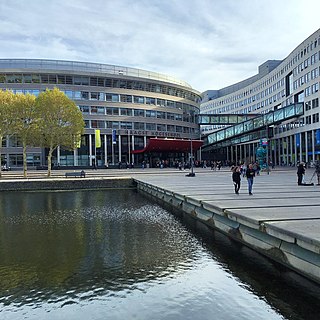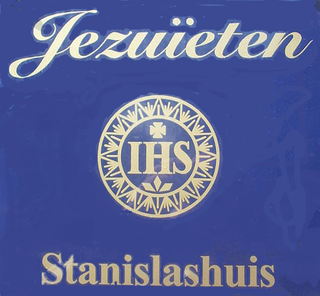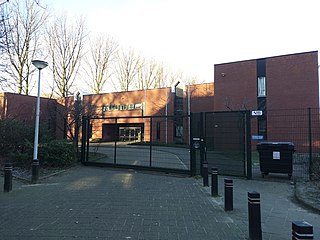
The Netherlands, informally Holland, is a country located in northwestern Europe with overseas territories in the Caribbean. It is the largest of the four constituent countries of the Kingdom of the Netherlands. The Netherlands consists of twelve provinces; it borders Germany to the east and Belgium to the south, with a North Sea coastline to the north and west. It shares maritime borders with the United Kingdom, Germany, and Belgium. The official language is Dutch, with West Frisian as a secondary official language in the province of Friesland. Dutch, English, and Papiamento are official in the Caribbean territories.

Demographic features of the population of the Netherlands include population density, ethnicity, education level, health of the population, economic status, religious affiliations and other aspects of the population.

Education in the Netherlands is characterized by division: education is oriented toward the needs and background of the pupil. Education is divided over schools for different age groups, some of which are divided in streams for different educational levels. Schools are furthermore divided in public, special (religious), and general-special (neutral) schools, although there are also a few private schools. The Dutch grading scale runs from 1 to 10 (outstanding).

Sint Eustatius, known locally as Statia, is an island in the Caribbean. It is a special municipality of the Netherlands.

Education in Belgium is regulated and for the most part financed by one of the three communities: Flemish, French and German-speaking. Each community has its own school system, with small differences among them. The federal government plays a very small role: it decides directly the age for mandatory schooling and indirectly the financing of the communities.
Dutch universities are supported by state funding so that universities do not have to rely on private funding to pay for tuition. All citizens of the Netherlands who complete high school at the pre-academic level (vwo) or have a professional Propedeuse at HBO level, signifying they have finished their first year course, are eligible to attend university. In the case of a HBO-Propedeuse some restrictions may apply as to deficiencies in High School subjects. Three universities have restrictive requirements based on academic ability; and all universities have restrictive requirements for some of their programs because the number of prospective students sometimes outnumbers the number of available places.

The Royal Academy of Art is an art and design academy in The Hague, offering programs at both the HBO bachelor's and master's levels, as well as PhD programs.

Subtitles are texts representing the contents of the audio in a film, television show, opera or other audiovisual media. Subtitles might provide a transcription or translation of spoken dialogue. Although naming conventions can vary, captions are subtitles that include written descriptions of other elements of the audio ,like music or sound effects. Captions are thus especially helpful to people who are deaf or hard-of-hearing. Subtitles may also add information that is not present in the audio. Localizing subtitles provide cultural context to viewers. For example, a subtitle could be used to explain to an audience unfamiliar with sake that it is a type of Japanese wine. Lastly, subtitles are sometimes used for humor, as in Annie Hall, where subtitles show the characters' inner thoughts, which contradict what they were saying in the audio.

The Van der Capellen Scholengemeenschap is a Dutch high school, named after the famous Dutch nobleman Joan van der Capellen tot den Pol. It has locations in the Dutch cities and towns of Zwolle, Elburg, Dedemsvaart and Wijhe:
The education in the Flemish Community covers the Dutch-speaking part of Belgium and consists of three networks (netten): government-provided education (gemeenschapsonderwijs), subsidized public schools and subsidized free schools.

The predominant language of the Netherlands is Dutch, spoken and written by almost all people in the Netherlands. Dutch is also spoken and official in Aruba, Bonaire, Belgium, Curaçao, Saba, Sint Eustatius, Sint Maarten and Suriname. It is a West Germanic, Low Franconian language that originated in the Early Middle Ages and was standardised in the 16th century.

The Hague University of Applied Sciences is a university of applied sciences with its campuses located in and around The Hague in the Randstad metropolitan region in the west of the Netherlands. The city is home to the Dutch government, royal family and many major international legal, security and peace institutions. Since the university was founded in 1987 it has expanded to four campuses in the near-side cities of The Hague, Delft and Zoetermeer. The main campus in The Hague is located behind The Hague Hollands Spoor railway station by the Laakhaven Canal.

Sint Maarten is a constituent country of the Kingdom of the Netherlands in the Caribbean region of the Americas. With a population of 41,486 as of January 2019 on an area of 34 km2 (13 sq mi), it encompasses the southern 44% of the divided island of Saint Martin, while the northern 56% of the island constitutes the French overseas collectivity of Saint Martin. Sint Maarten's capital is Philipsburg. Collectively, Sint Maarten and the other Dutch islands in the Caribbean are often called the Dutch Caribbean.
Amsterdam University of Applied Sciences is a large vocational university located in Amsterdam, Netherlands. The AUAS mainly offers bachelor's degree programmes, but also has a number of (professional) master's degree programmes. For students from the AUAS' international partner institutes it is possible to study at the AUAS as an exchange student.
Pre-vocational secondary education is a school track in the Netherlands. It lasts four years, from the age of twelve to sixteen. It combines vocational training with theoretical education in languages, mathematics, history, arts, and sciences. Sixty percent of students nationally are enrolled in VMBO. VMBO has five different levels; in each a different mix of practical vocational training and theoretical education is combined:
Dutch Afghans are Dutch citizens and non-citizen residents born in, or with ancestors from, Afghanistan. In 2015 there were 44,000 Dutch Afghans, which form one of the largest Afghan diaspora communities as well as one of the main Asian communities in the Netherlands. Most of the first generation population originally settled in the Netherlands between 1992 and 2001.
Colegio Arubano is a secondary school in Aruba that serves students in grades seven through twelve from one of its two campuses in either the capital city of Oranjestad or the southern community of Sint Nicolaas. The two campuses have been separated now, and the school in Sint Nicolaas has become a different school with the new name Colegio Nigel Matthew.
The Bataafs Lyceum is a public high school in Hengelo, Netherlands. The Bataafs Lyceum is part of a public school division called the Openbare Scholengemeenschap Hengelo and offers HAVO and VWO level education.

St Stanislas College is a conglomerate of private Catholic secondary schools located in Delft, Pijnacker, and Rijswijk, in the province of South Holland, in the Netherlands.

The Japanese School of Amsterdam is a Japanese international school in Amsterdam. As of 1997 the JSA is the Japanese school for about 66% of the Japanese nationals in the country.













